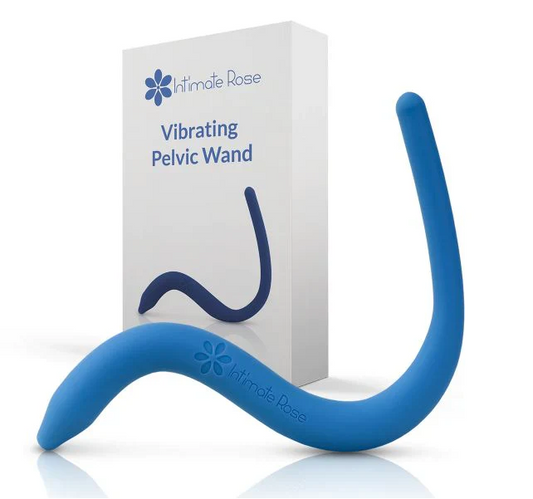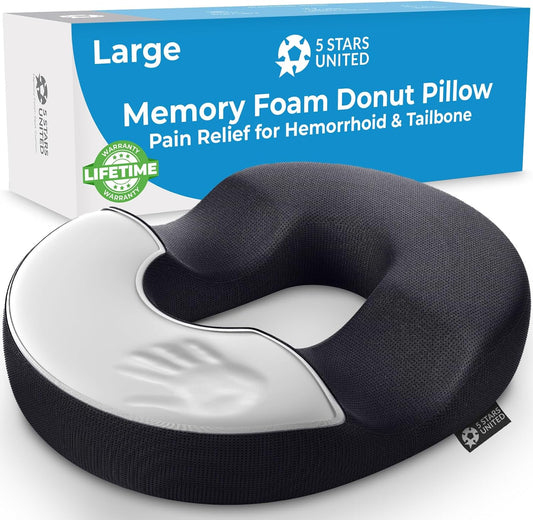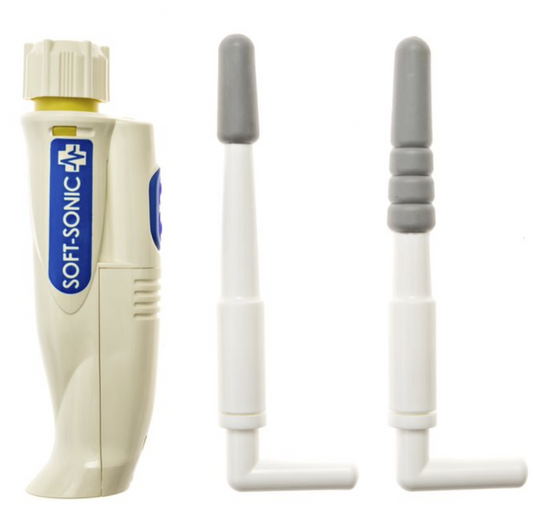
How to Use a Prostate Massager for Maximum Health Benefits (Not Just Pleasure!)
Share
These days, men's health discussions are expanding beyond traditional topics. More men are exploring comprehensive approaches to wellbeing, including prostate massage.
While prostate massage might make some blush, understanding its potential health benefits beyond pleasure could be key to improving your overall well-being.
In this article, we’ll explain how to use a prostate massager and the health benefits it may offer.
Understanding the Prostate
The prostate is a small gland about the size of a walnut, located just below the bladder and surrounding the urethra. It produces 25% to 30% of the fluid that makes up semen, contributing significantly to the total volume released during ejaculation.
During childhood, the prostate is very small, about the size of a pea. In young adult men aged 20 to 30, it typically weighs 15-20 grams and has a volume of 20-35 cubic centimeters.
By age 60, many men's prostates weigh around 40 grams, and by age 80, some can grow to 50-100 grams, nearly four times their original size.
One of the most common prostate issues is Benign Prostatic Hyperplasia (BPH), which affects about half of men over 50. This condition causes the prostate to enlarge, leading to frustrating urinary symptoms that can disrupt daily life.
Prostatitis, or inflammation of the prostate, is another widespread concern. It affects roughly 10–15% of American men at some point and often appears suddenly.
Despite the prostate's crucial role, many men only start paying attention to it when symptoms become unavoidable. Yet its influence goes far beyond urination.
Prostate health is also closely tied to sexual function, with issues in this small gland often affecting erectile performance and overall satisfaction.
What is a Prostate Massager?
A prostate massager is a device specifically designed for massaging the prostate gland. It typically features a curved shape similar to a finger to mimic traditional digital prostate massage.
These specialized tools are engineered with male anatomy in mind to ensure safe and effective prostate stimulation.
Prostate massagers come in two main varieties. Manual massagers require physical manipulation and give the user more control over pressure and movement.
Meanwhile, electronic massagers offer hands-free stimulation and often feature different vibration patterns for a customizable experience.
Medical vs. Recreational Prostate Massage
Medical prostate massage is used to help diagnose or treat certain prostate conditions. It is often done with a prostate health massager under clinical supervision. This type of massage uses gentle stimulation to reduce inflammation, relieve congestion, or collect fluid for testing.
Recreational prostate massage, on the other hand, is done privately at home. Many men use it for wellness, relaxation, or sexual pleasure. It may help improve circulation, support prostate function, and enhance overall comfort.
What are the Health Benefits of Prostate Massage?
While prostate massage is often associated with pleasure, some studies and clinical reports suggest it also offers a range of health benefits.
Relief from Prostatitis Symptoms
For men dealing with the persistent discomfort of chronic prostatitis or chronic pelvic pain syndrome (CPPS), prostate massage may offer a meaningful form of relief.
This technique helps release trapped prostatic fluid, which could otherwise contribute to inflammation, pressure, and pain in the gland.
While prostate massage should not replace medical treatment, some clinicians include it as a supportive therapy. Many men report noticeable symptom relief when prostate massage is added to their regular care routine under medical supervision.
In one study involving 73 men with chronic pelvic pain syndromes, participants were treated with a combination of antibiotics and regular prostate massage. The outcomes showed that 40% experienced complete resolution of symptoms.
This suggests that prostate massage may be beneficial for some men, particularly when used alongside conventional therapies.
Improved Urinary Flow in BPH
Many men struggling with Benign Prostatic Hyperplasia have discovered that periodic prostate massage temporarily improves urinary flow and reduces related symptoms.
A study involving five men with acute urinary retention due to BPH found that repetitive prostate massage, combined with antimicrobial therapy and alpha-blockers, resulted in significant improvements.
All participants were able to urinate normally, and on average, they were able to avoid transurethral resection of the prostate (TURP) for 2.5 years.
Another study reported a 30% reduction in prostate volume in a 55-year-old man after three weeks of bi-weekly prostate massage for mild BPH symptoms.
Enhanced Sexual Function
Beyond specific health conditions, prostate stimulation often dramatically enhances sexual experiences for men regardless of their baseline function.
Regular prostate massage increases blood flow throughout the entire pelvic region, not just the prostate itself. This improved circulation subsequently supports better erectile function and sensitivity.
Another most commonly reported benefit of prostate massage is stronger, more satisfying orgasms. Because the prostate has many nerve endings and plays a key role in ejaculation, targeted massage often leads to more intense and satisfying climaxes.
Some men also find that prostate massage helps clear the seminal pathways. This makes ejaculation more comfortable.
How to Use a Prostate Massager Safely
Using a prostate massager safely involves careful preparation, technique, and hygiene.
Apply Lubrication
Before beginning, always start with thorough hand washing and proper cleaning of your device according to manufacturer instructions.
Once prepared, find a comfortable position that allows for relaxation. Many beginners discover that lying on their side with knees slightly bent offers the ideal combination of comfort and access.
Apply a generous amount of lubricant to both the device and your anal area, ensuring thorough coverage. This step should never be skipped, as sufficient lubrication prevents discomfort and potential tissue damage.
Water-based lubricants generally work well with most materials and won't damage silicone devices the way silicone-based lubricants might.
Insert and Position the Massager
The most crucial element for successful insertion involves relaxing your body through deep, steady breathing.
When you feel ready, gently insert the narrower end of the massager past the sphincter muscles using very light pressure. Move deliberately, taking your time with this process. There's absolutely no rush, and forcing insertion will only create discomfort or potential injury.
Once comfortably inserted, adjust the position of the device so it points toward your belly button. The prostate sits approximately 2-3 inches inside the rectum, toward the front of your body (anterior wall).
You'll likely feel a distinctive pressure or pleasurable sensation when the massager makes proper contact with the prostate gland.
Activate and Let It Work
For electronic massagers, begin with the lowest available intensity setting before gradually increasing as your comfort allows.
With manual devices, experiment with gentle rocking motions or small circular movements that maintain consistent contact with the prostate without creating discomfort.
A typical session lasts approximately 10-20 minutes, though this varies considerably based on personal preference and specific health goals. Always stop immediately if you experience any pain or significant discomfort.
After completion, carefully remove the device and clean it thoroughly according to manufacturer guidelines.
External vs. Internal Prostate Massage
If you're new to prostate massage or have concerns about internal stimulation, beginning with external massage is perfectly acceptable.
External massage involves applying pressure to the perineum (the area between the scrotum and anus) to indirectly stimulate the prostate. This can help improve circulation and reduce discomfort in the pelvic area.
Many men eventually transition to internal massage once they become more comfortable with the practice.
For therapeutic purposes, internal massage provides direct contact with the prostate, offering precise stimulation and better fluid release, which can help alleviate symptoms of prostatitis or BPH.
However, the best approach is always the one you'll maintain consistently and comfortably as part of your wellness routine.
How to Choose the Best Prostate Massager
If you're considering a prostate massager, it's crucial to prioritize safety and choose wisely. Here's a guide on how to select one:
Start with Basic Models for Beginners
Beginners should begin with smaller, simpler devices that have gentle curves and smooth surfaces. These are designed for comfort while still providing effective stimulation.
As you become more comfortable, you can upgrade to more advanced models with features like multiple vibration patterns, adjustable intensities, or remote controls for hands-free use.
Consider Your Health and Wellness Goals
Consider your health and wellness goals when choosing a device. Some massagers focus on pleasure, while others are designed for therapeutic benefits, such as effective prostate drainage or specific pressure patterns.
The best models balance both aspects, offering versatile options for complete prostate care.
Read User Reviews for Insights
User reviews consistently emphasize the importance of high-quality materials when choosing a prostate massager.
To make an informed decision, research different brands and read user reviews carefully. Focus on feedback about comfort, effectiveness, ease of use, and durability. Be cautious of overly positive or suspiciously perfect reviews, as they may not be genuine.
Who Should Avoid Prostate Massage?
While prostate massage can offer benefits for many, certain individuals should avoid it due to potential risks, including:
- Acute Prostatitis: Men with acute bacterial prostatitis should avoid prostate massage, as it could potentially spread infection.
- Recent Surgery: If you've had recent rectal, prostate, or pelvic surgery, wait until fully healed and cleared by your doctor.
- Prostate Cancer: Men with prostate cancer should consult their oncologist before attempting prostate massage.
- Rectal Health Issues: Those with hemorrhoids, anal fissures, or other rectal health concerns should avoid internal massage until these conditions heal.
- Bleeding Disorders: If you have a bleeding disorder or take blood thinners, consult your doctor first.
If you experience unexplained rectal bleeding or severe pain during bowel movements, obtain proper diagnosis before attempting prostate massage.
Experience Next-Level Prostate Wellness with the Sonic Prostate Massager
The revolutionary Sonic Prostate Massager from Prostate Health Store combines therapeutic sonic vibrations with anatomically perfected design.
With its dual attachments for beginners and experienced users alike, this waterproof device has helped countless men improve urinary function, reduce discomfort, and enhance sexual wellness.
Incorporate this top-rated massager into your routine 2-3 times weekly for maximum benefits, and join the thousands of health-conscious men nationwide who've transformed their prostate health with this essential wellness tool.
Why wait for prostate discomfort to impact your quality of life? Purchase our Sonic Prostate Massager today and take control of your prostate wellness from the comfort of your own home.




